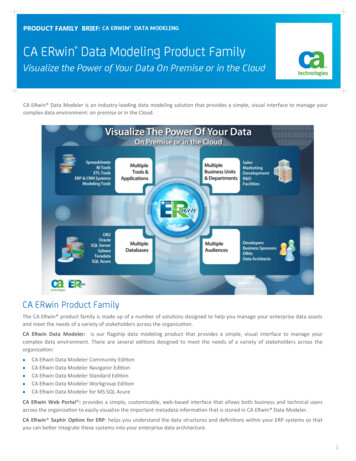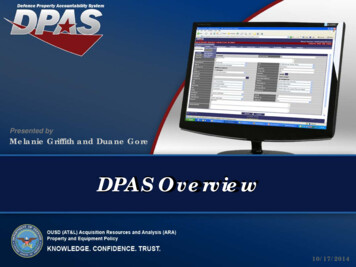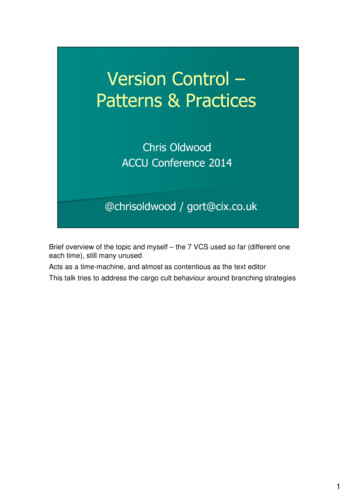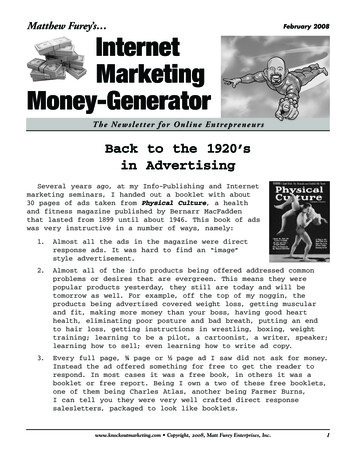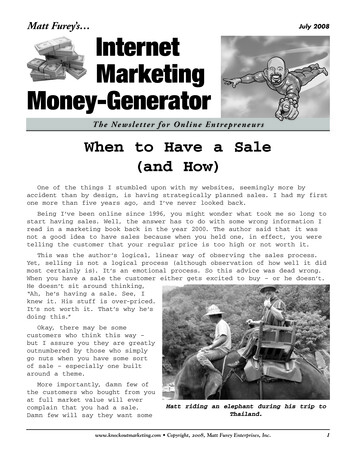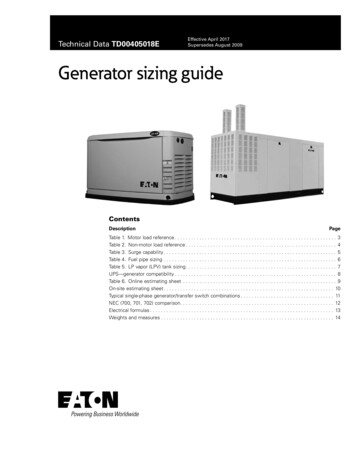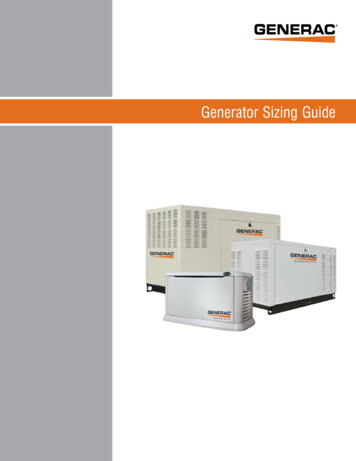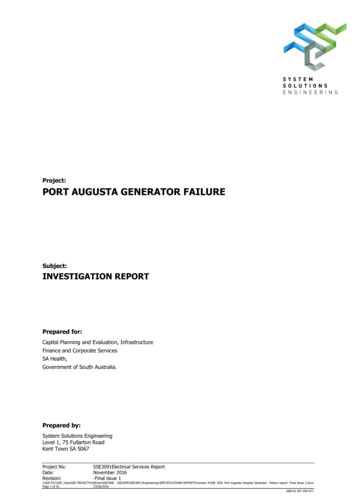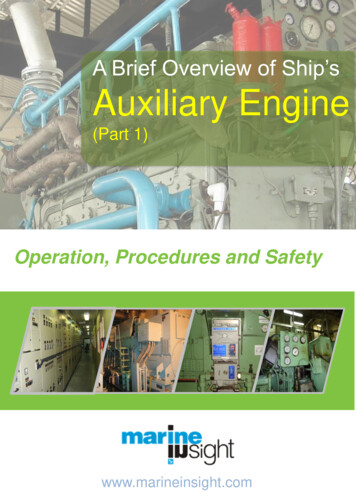
Transcription
A Brief Overview of Ship’sAuxiliary Engine(Part 1)Operation, Procedures and Safetywww.marineinsight.com
Marine Insight “A Brief Overview of Ship’s Auxiliary Engine- Part 1”Publication date: Aug’ 2016Editor : Raunek KanthariaPublished by: Marine Insightwww.marineinsight.comGraphic Design: Anish WankhedeCopyright 2016 Marine InsightNOTICE OF RIGHTSAll rights reserved. No part of this book may berewritten, reproduced, stored in a retrieval system,transmitted or distributed in any form or means,without prior written permission of the publisher.NOTICE OF LIABILITYThe authors and editors have made every effortpossible to ensure the accuracy of the informationprovided in the book. Neither the authors and MarineInsight, nor editors or distributors, will be held liablefor any damages caused either directly or indirectly bythe instructions contained in this book, or theequipment, tools, or methods described herein.
Basic Operations of Marine Auxiliary Engine1 Power GenerationSynchronizationBlackout SituationImportant Procedures2 3Part 1Starting / Stopping ProcedurePerformanceFuel Changeover ProcedureImportant Safety Inclusions 4Over-speed TripAir Circuit BreakerPreferential TripOther Safety Alarms and TripsImportant Assessment of Auxiliary Engine 5To be continued in next partMaintenance Tips for Marine Generator 3Part 2To be continued in next free partTitle of the bookMarine Insight’s Free Resource for Smart Seafarer
Marine auxiliary engines are manufactured keeping in mind therigorous environment they will be installed and operated in, along withmaintaining the continuity of operation to provide uninterrupted powersupply to various ship systems.The most important thing for running the machinery system in itsbest capabilities is to know the correct operating procedure for the sameand to bring the machinery back in operation following correct sequenceand troubleshooting procedure if it is stopped due to unavoidablecircumstances. The ship’s engineer in-charge must familiarizehimself/herself with the operating manual of the auxiliary engine, thecorrect operating parameters and scheduled planned maintenance.4A Brief Overview of Ship’s Auxiliary Engine
www.marineinsight.comA ship is like a floating city with all the privileges enjoyed by anynormal city on shore. Just like a conventional city, the ship alsorequires all the basic amenities to sustain life on board; themain among them is power or electricity. Let’s take alook as to how power is generated and supplied on board a ship.Shipboard power is generated using a prime mover and an alternatorworking together. For this an alternating current generator is used onboard. The generator works on the principle that when a magneticfield around a conductor varies, a current is induced in the conductor.The generator consists of a stationary set of conductors wound incoils on an iron core. This is known as the stator. A rotating magnetcalled the rotor turns inside this stator producing magnetic field. Thisfield cuts across the conductor, generating an induced EMF orelectro-magnetic force as the mechanical input causes the rotor toturn. The magnetic field is generated by induction (in a brushlessalternator) and by a rotor winding energized by DC current throughslip rings and brushes.Few points to be noted about power on board are : AC, 3 phasepower is preferred over DC as it gives more power for the same size.3 phases is preferred over single phase as it draws more power andin the event of failure of one phase, other 2 can still work.5A Brief Overview of Ship’s Auxiliary Engine
www.marineinsight.comPower Distribution On BoardThe Power Distributed on board a ship needs to be supplied efficientlythroughout the ship. For this the power distribution system of the shipis used. A shipboard distribution system consists of differentcomponents for distribution and safe operation of the system. They areas follows: Ship Generator consisting of prime mover and alternator Main switch board which is a metal enclosure, taking power from thediesel generator and supplying it to different machinery systems6A Brief Overview of Ship’s Auxiliary Engine
www.marineinsight.com Bus Bars which acts as a carrier and allow transfer of load fromone point to another Circuit breakers which act as a switch and in unsafe conditioncan be tripped to avoid breakdown and accidents Fuses as safety devices for machinery Transformers to step up or step down the voltage When supply is to be given to the lighting system, a step downtransformer is used in the distribution system In a power distribution system, the voltage at which the systemworks is usually 440v There are some large installations where the voltage is as highas 6600v Power is supplied through circuit breakers to large auxiliarymachinery at high voltage For smaller supply fuse and miniature circuit breakers are used The distribution system is three wires and can be neutrallyinsulated or earthed Insulated system is more preferred as compare to earthedsystem because during an earth fault essential machinery suchas steering gear can be lostThe More You Know YourMachine, The Better It WillPerform.7A Brief Overview of Ship’s Auxiliary Engine
www.marineinsight.comSynchronizing of an incoming generator or alternator is veryimportant before paralleling it with another generator. Thesynchronizing of the generator is done with the help of synchrosscope or with three bulb method in case of emergency. It is ofutmost importance that before paralleling the generators thefrequency and voltage of the generators need to be matched. Inthis article we will describe the method for synchronizing generators on a ship.There are two methods to synchronize generators on a ship – oneis the normal and other is the emergency method.Synchroscope method The synchroscope consists of a small motor with coils on thetwo poles connected across two phases Let’s say it is connected in red and yellow phases of theincoming machine and armature windings supplied from red andyellow phases from the switchboard bus bars The bus bar circuit consists of an inductance and resistanceconnected in parallel.8A Brief Overview of Ship’s Auxiliary Engine
www.marineinsight.com The inductor circuit has the delaying current effect by 90degrees relative to current in resistanceŸ These dual currents are fed into the synchroscope with the helpof slip rings to the armature windings which produces a rotatingmagnetic field The polarity of the poles will change alternatively in north/southdirection with changes in red and yellow phases of the incomingmachine Ÿ The rotating field will react with the poles by turning the rotoreither in clockwise or anticlockwise directionŸ9A Brief Overview of Ship’s Auxiliary Engine
www.marineinsight.com If the rotor is moving in clockwise direction this means that theincoming machine is running faster than the bus bar and slowerwhen running in anticlockwise direction Ÿ Generally, it is preferred to adjust the alternator speed slightlyhigher, which will move the pointer on synchroscope is inclockwise direction Ÿ The breaker is closed just before the pointer reaches 12 o’clockposition, at which the incoming machine is in phase with the busbarEmergency synchronizing lamps or three bulb methodThis method is generally used when there is a failure ofsynchroscope. In case of failure a standby method should beavailable to synchronize the alternator, and thus the emergency lampmethod is used.Three lamps should be connected between three phases of thebus bar and the incoming generator should be connected as shownin the diagram: The lamps are connected only in this manner because if they areconnected across, the same phase lamps will go on and offtogether when the incoming machine is out of phase with theswitchboard Ÿ10A Brief Overview of Ship’s Auxiliary Engine
www.marineinsight.com In this method, as per the diagram, the two lamps will be bright andone lamp will be dark when incoming machine is coming in phasewith the bus barŸ The movement of these bright and dark lamps indicates whetherthe incoming machine is running faster or slowerŸ For e.g. there is a moment when lamp A will be dark and lamp B &C will be bright, similarly there will be instance when B is dark andothers are bright and C is dark and other two are bright This example indicates that machine is running fast and themovement of the lamps from dark and bright gives a clockwisemovement Ÿ11A Brief Overview of Ship’s Auxiliary Engine
www.marineinsight.com Clockwise movement indicates fast and anti-clockwise directionindicates slow running of incoming generator The lamps are connected only in this manner because if they areconnected across, the same phase lamps will go on and offtogether when the incoming machine is out of phase with theswitchboard Ÿ In this method as per the diagram the two lamps will be bright andone lamp will be dark when incoming machine is coming in phasewith the bus bar The movement of these bright and dark lamps indicates whetherthe incoming machine is running faster or slowerFor e.g. there is a moment when lamp A will be dark and lamp B & Cwill be bright, similarly there will be instance when B is dark andothers are bright and C is dark and other two are bright. Thisexample indicates that machine is running fast and the movement ofthe lamps from dark and bright gives an clockwise movement.Clockwise movement indicates fast and anti-clockwise directionindicates slow running of incoming generator.12A Brief Overview of Ship’s Auxiliary Engine
Must-Have Guides for Professional Marine Engineers
www.marineinsight.comBlackout is one condition each and everymariner is familiar with and also afraid of. It isone situation everyone on the ship is terrifiedof because it brings the whole ship to astandstill. From bridge to engine room, fromdinning crew members to the sleeping ones,everyone is affected by a blackout.Understanding Blackout Condition“Never panic in suchsituation, be calm andcomposed. Emergencygenerator will restore thepower in no time”Blackout condition is a scenario on aship, wherein the main propulsion plant andassociate machinery such as boiler, purifierand other auxiliaries stop operating due tofailure of power generation system of the ship– Generator and alternator.With technologies and automation, measuresare provided to avoid such blackout situationby means of auto-load sharing system andauto-standby system in which the generatorset that is running in parallel or standbycomes on load automatically if the runningdiesel generator fails.14A Brief Overview of Ship’s Auxiliary Engine“It requires both skill andpatience to tackle a situationlike blackout specially whenthe vessel is sailing ormaneuvering. However, thebest way to tackle suchsituations is to be calm andcomposed; and to know yourengine room and machinerywell in advance”
www.marineinsight.comWhat to Do in Case of a Blackout?In case of blackout following precautions and actions should betaken: Inform officer on bridge briefly about the condition. Call for manpower and inform the chief engineer If the main propulsion plant is running, bring the fuel lever tozero position Close the feed of the running purifier to avoid overflow andwastage of fuel If auxiliary boiler was running, shut the main steam stop valve tomaintain the steam pressure Find out the problem and reason for blackout and rectify thesame Before starting the generator set, start the pre- lubricationpriming pump if the supply for the same is given from theemergency generator; if not, then use manual priming handle(provided in some generator) Start the generator and take it on load. Then immediately startthe main engine lube oil pump and main engine jacket waterpump Reset breakers and start all the other required machinery andsystem. Reset breakers that are included in preferential trippingsequence (Non-essential machinery)15TitleABriefof theOverviewbook of Ship’s Auxiliary Engine
www.marineinsight.comKnow Your Machine16TitleABriefof theOverviewbook of Ship’s Auxiliary Engine
The new generation marine auxiliary engines are provided withstate-of- the-art automation and safety features, which reduce thehuman interference for operation of the machinery such as sequencestarting and stopping, manual load sharing etc. but it is still veryimportant to thoroughly understand the step-by-step procedures foroperating a marine generator engine in case of automation fault orwhen doing the running in checks after major overhauling.While operating the engine, it is the responsibility of the engineerin-charge to ensure the generator is working close to its maximumcapacity to achieve highest possible rated efficiency which require allthe basic operating procedures to be in correct order at all times.17A Brief Overview of Ship’s Auxiliary Engine
www.marineinsight.comA generator on a ship is the heart of the ship. It is thatlife-line which supports almost each and every function of the ship.Generator requires special care, attention, and maintenance for itseffective and economic running. Moreover, when it comes tooperating a generator on a ship, a standard procedure needs to befollowed considering several important aspects.Unlike the conventional generators that we use on land, a ship’sgenerator requires a special step-by-step method for starting andstopping it. Though not a very complex one, the process demands aproper system to be followed. Missing even a single step might leadto failure in starting or stopping the generator and can even result into“black-out”, a situation which everyone on ship tries their best to stayaway from. Let’s take a look at the step-by-step procedure for startingand stopping a generator on a ship.Generator starting procedureAutomatic Start This method is only possible if sufficient amount of starting air isavailable. The air valves and interlocks are operated like in the18A Brief Overview of Shi
– Generator and alternator. With technologies and automation, measures are provided to avoid such blackout situation by means of auto-load sharing system and auto-standby system in which the generator set that is running in parallel or standby comes on load automatically if the running diesel generator fails. “Never panic in such


